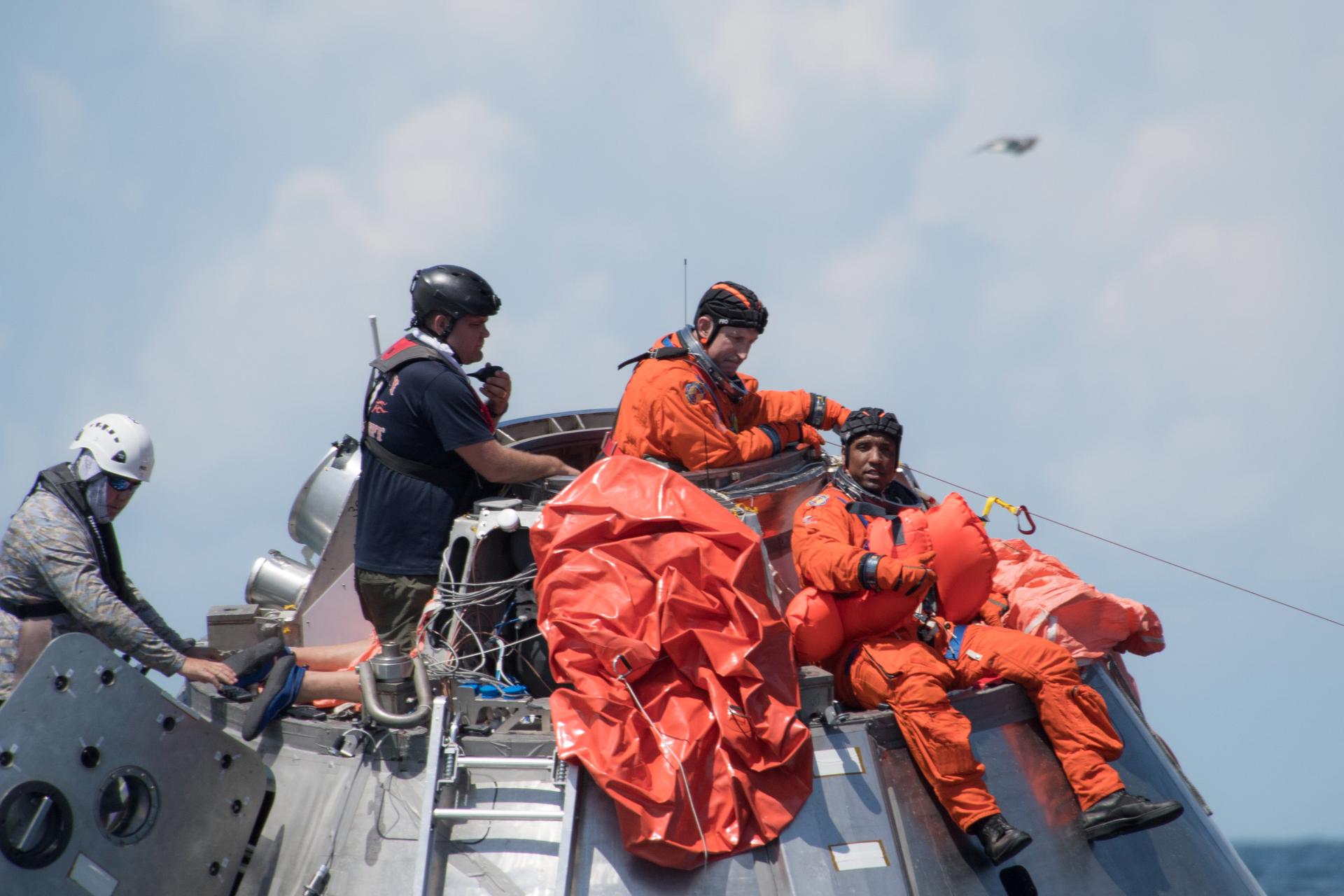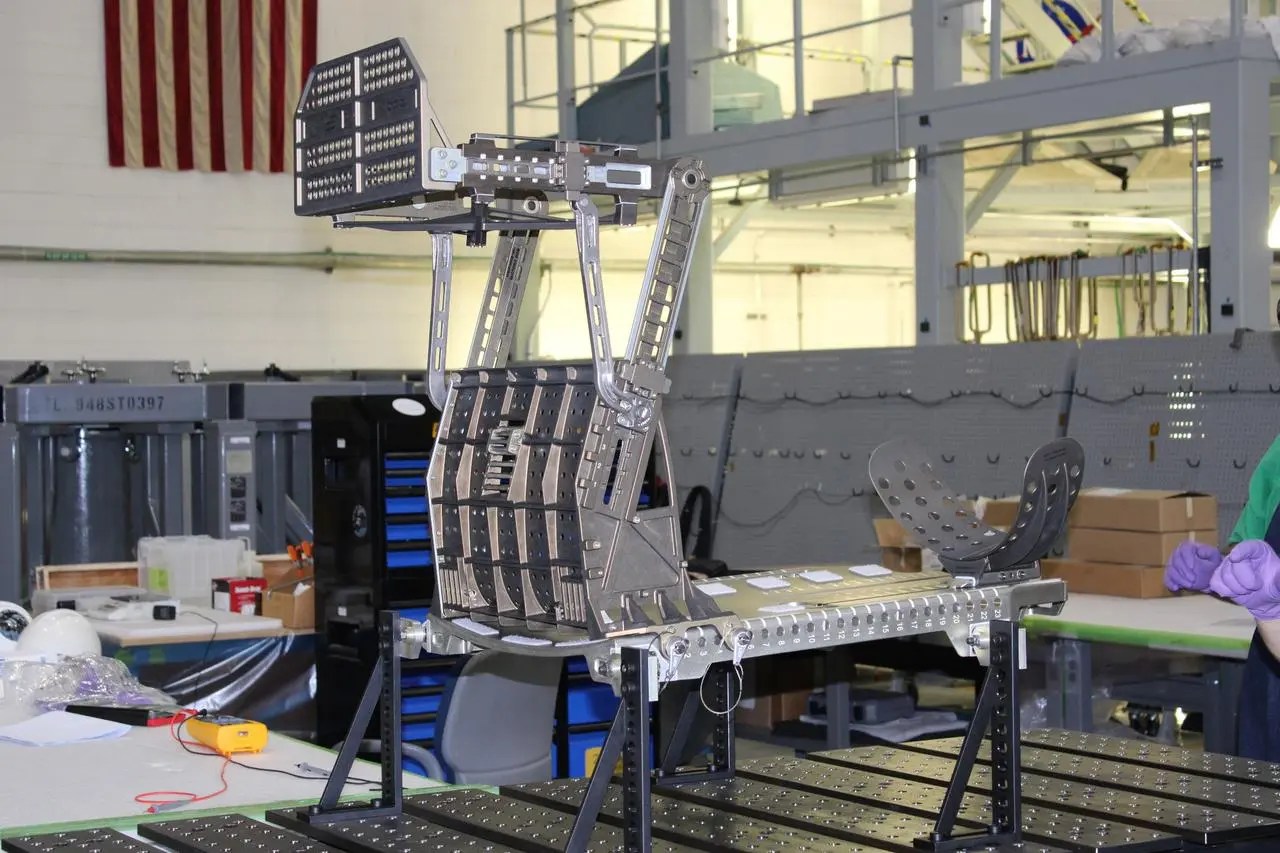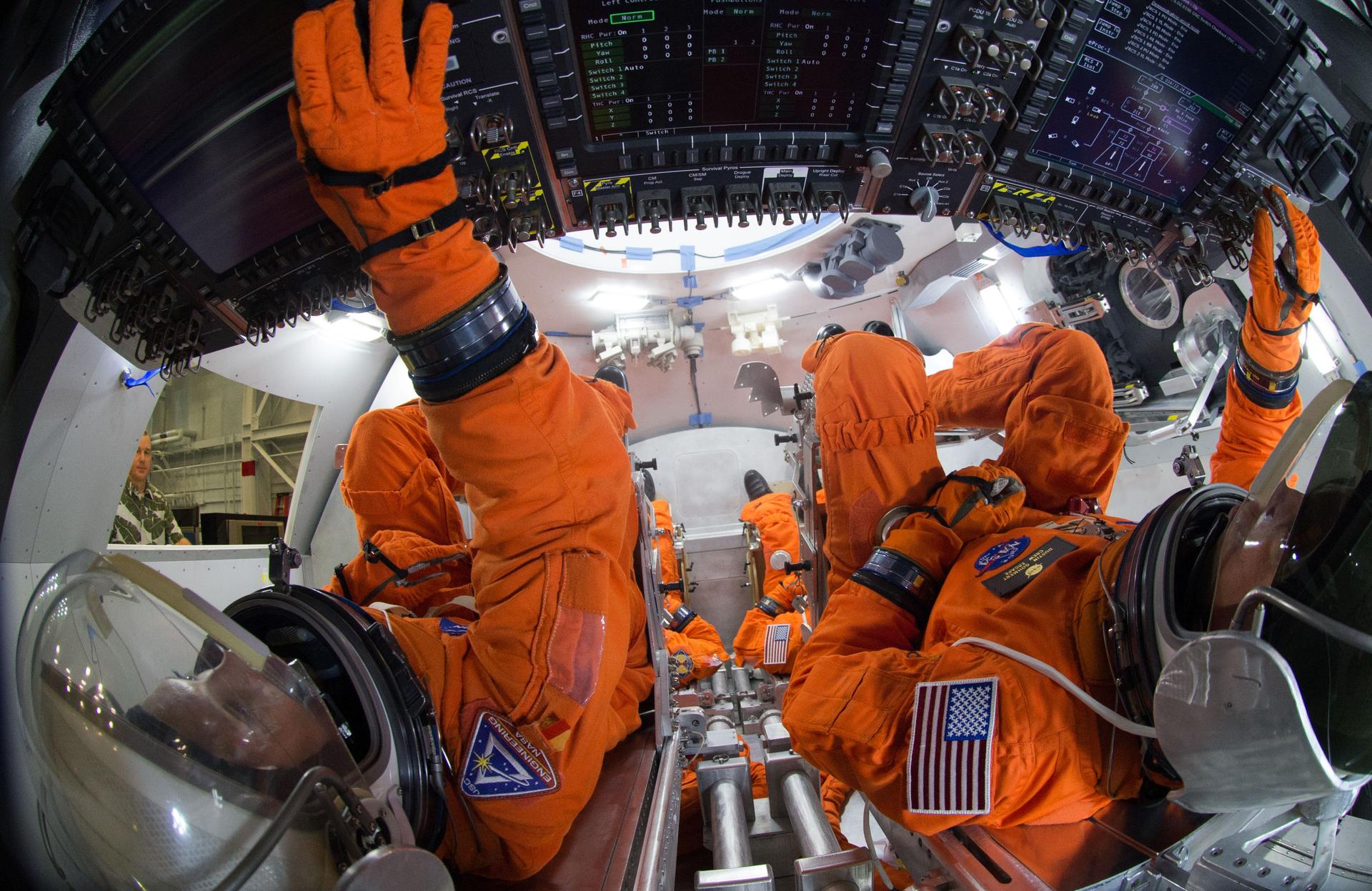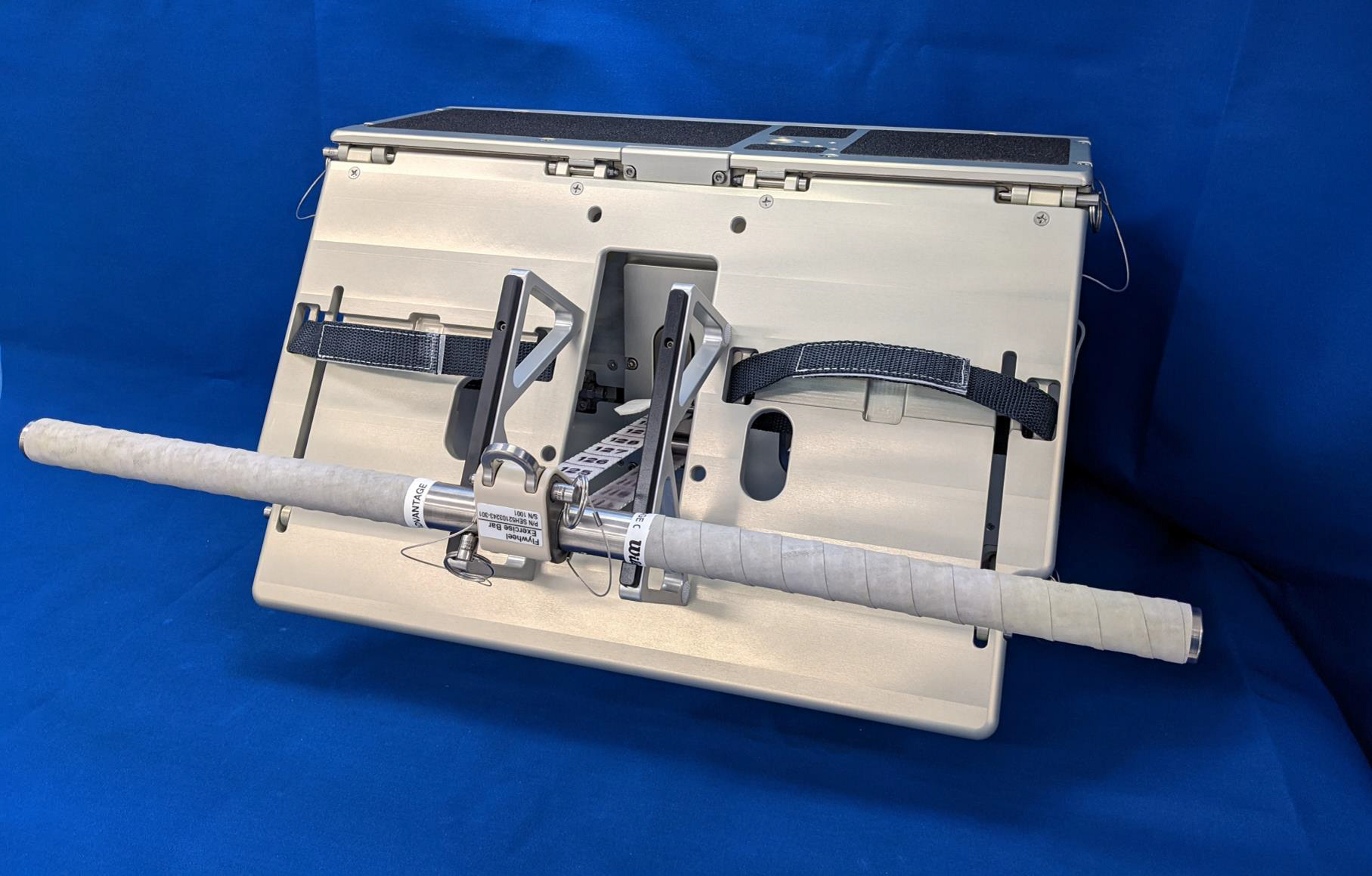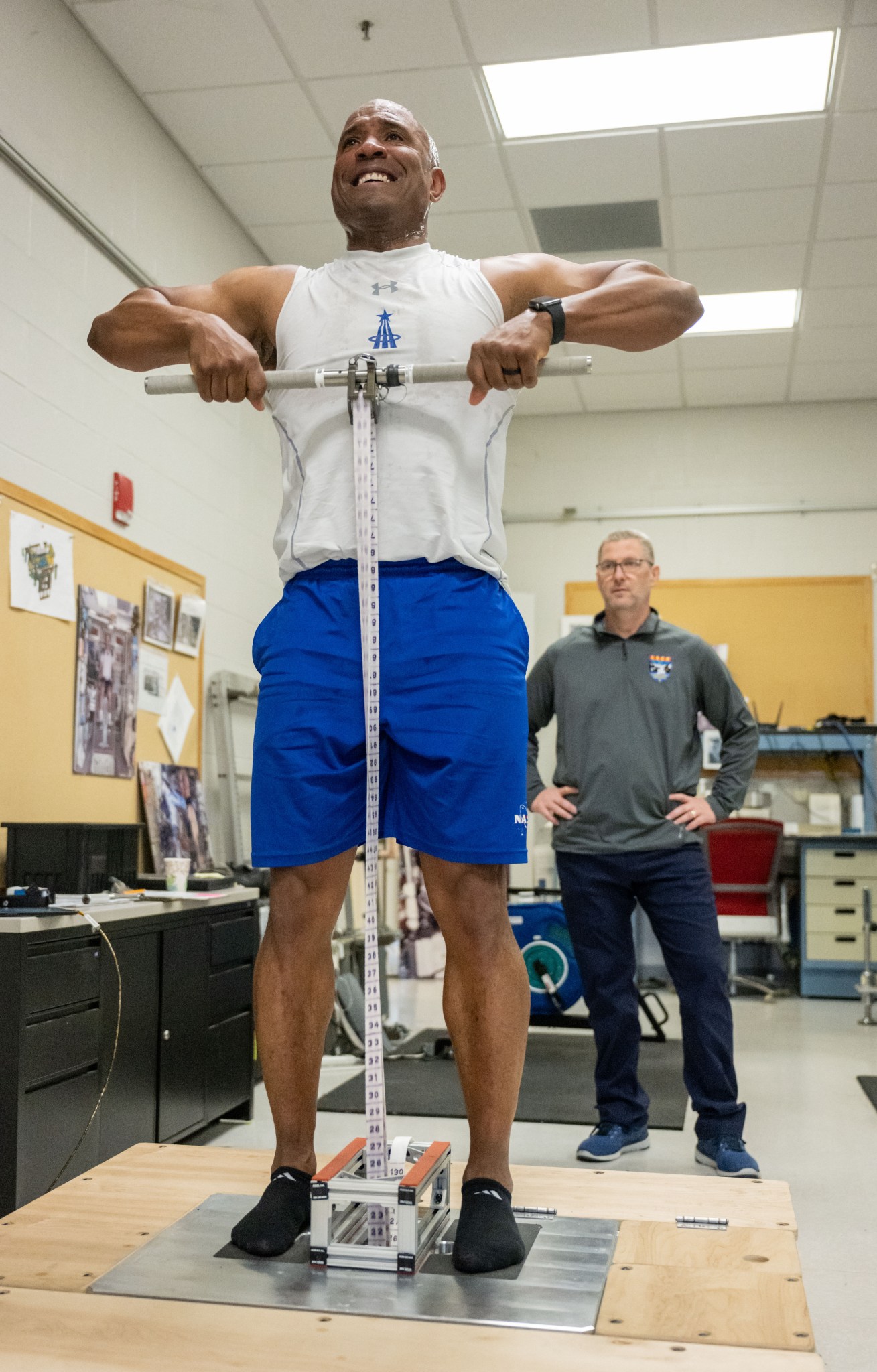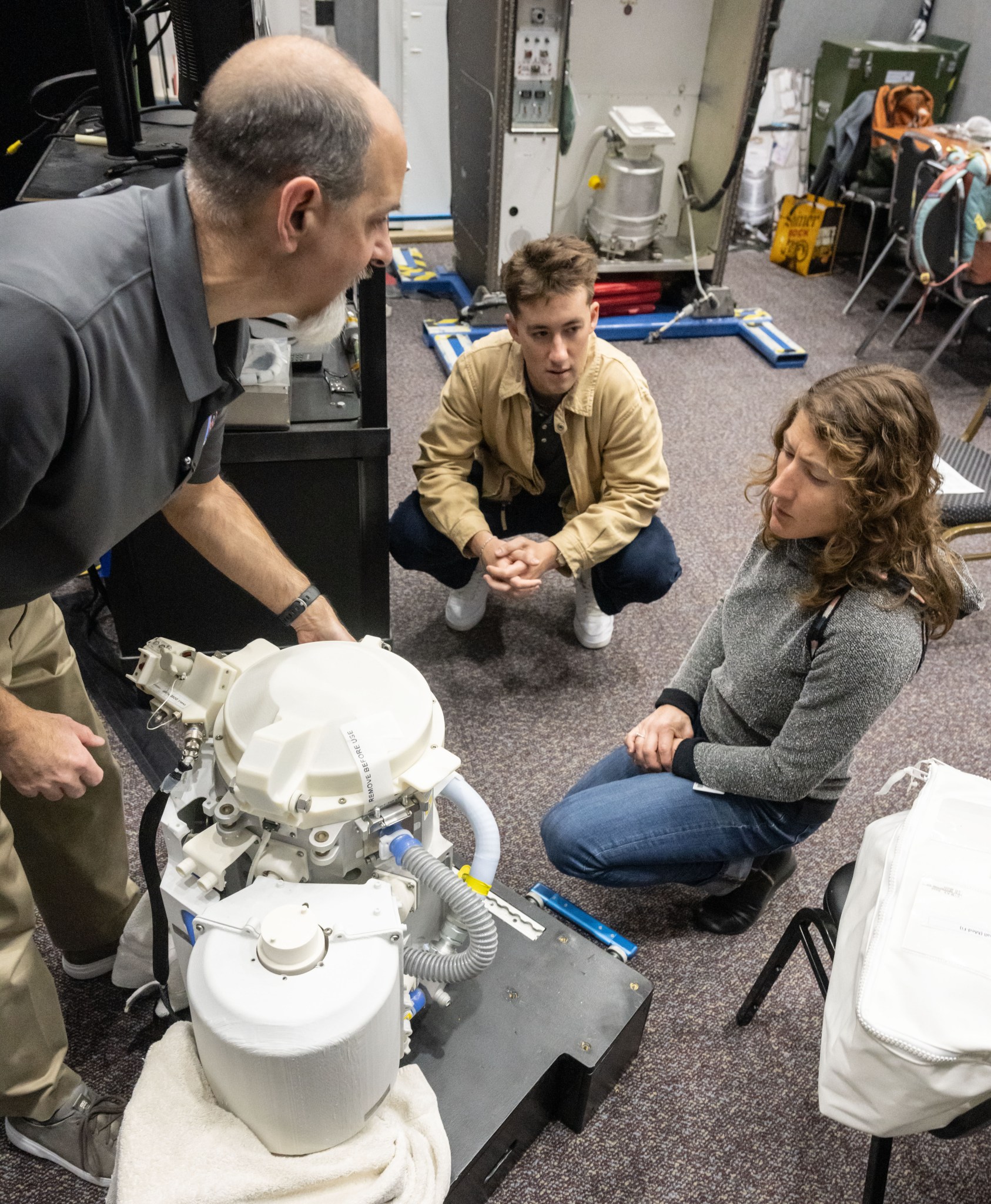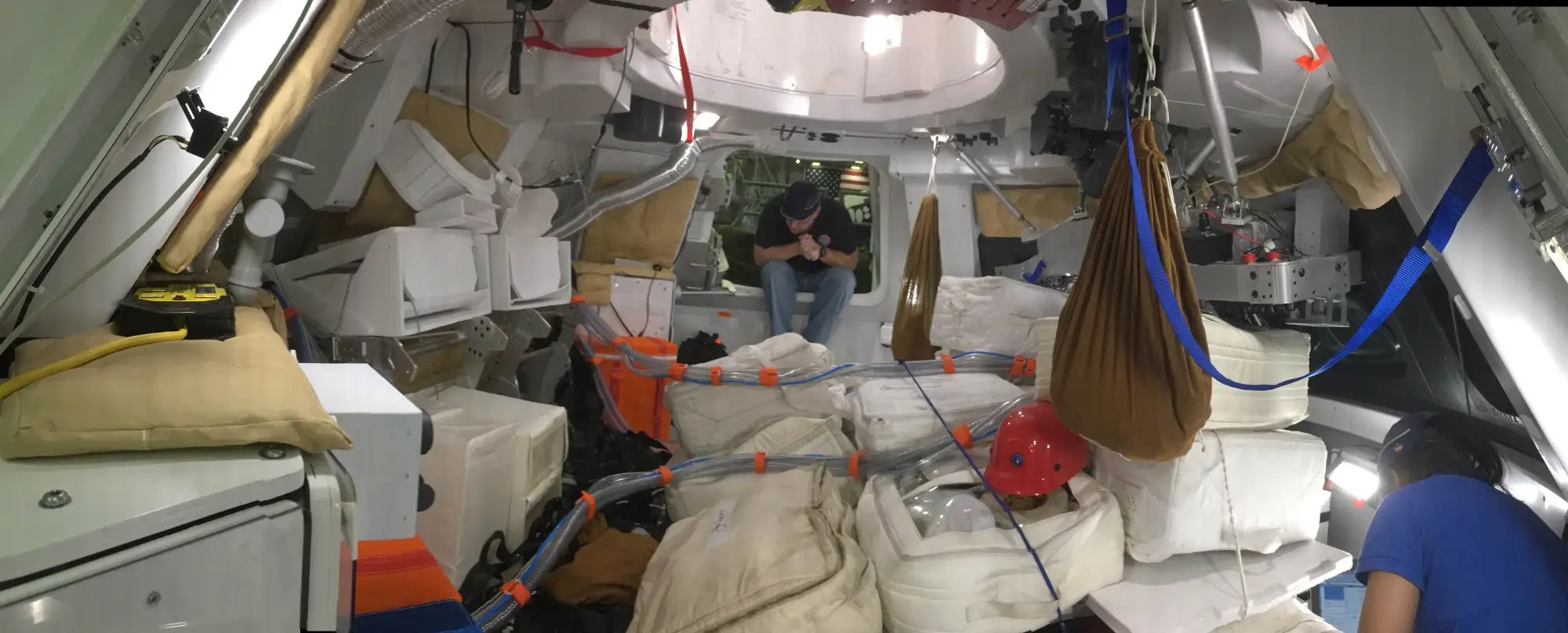Crew Systems
Orion has been specially designed and tested to make sure astronauts can live and work safely in the capsule during multi-week Artemis missions. Countless details inside and outside the spacecraft are meticulously thought through to ensure that astronauts are protected during anything they may encounter. From life support to spacesuits to crew accommodations, engineers have worked hard to evaluate and improve Orion’s features so that astronauts can complete missions in deep space comfortably, efficiently, and safely.

Crew Seats
The Orion crew module includes four crew seats. Viewed from the side hatch opening, the crew seats for the commander and pilot are located to the left side of side capsule, facing the display and control units placed an arm’s length away. The two other seats for the mission specialists are located on right side of the capsule. When configured for launch and re-entry, the astronauts will be lying on their backs and their knees bent at a 90-degree angle, with their feet resting on foot pans.
The seats are designed for anyone from the 1st to the 99th percentile of body anthropometries – from a 4-foot-10-inch, 94-pound female to a 6-foot-5-inch, 243-pound male. The seats can be adjusted in multiple ways the fit the astronauts more comfortably. This includes adjusting the seat pans, foot plate, head and arm rests of the seats and adjusting hand controller mounts to make sure that the smallest or largest of astronauts can reach all the controls. Once in space, the foot pans on the pilot and commander seats can be removed and stowed, allowing the crew to have more open space in the cabin.
The crew seats have features to help secure crewmembers during flight phases of the mission. A 5-point harness (seatbelt) restraint, a concave headrest, shoulder and hip bolsters, and a peg in the foot pan and locks into the crew boots minimize the movement of the crewmember’s body.
The seats also include a crew impact attenuation system (CIAS) that helps protect the Orion crew from excessive g-load during landing. The mechanism attaches to each crew seat and Orion’s backbone structure and helps absorb shock when Orion splashes into the ocean after returning to Earth. It decreases the impact energy the astronauts will feel and limits the load by allowing the seat to slide on guard rails. Each seat has six inches of room to slide, however, the CIAS will not slide back and forth during the regular vibrations of space flight and only engage on landing.
Displays and Controls
The Orion display and control equipment is the crew interface to the Orion systems. The displays and controls consist of three display units, seven switch interface panels, two rotational hand controllers, two translational hand controllers, and two cursor control devices. The switch panels and hand controllers’ hardware interfaces through serial interfaces to the power and data units, then via the onboard data network to either flight control modules or the display units for processing. The display units utilize a variety of display formats to provide data to the crew for awareness and action when necessary.
The Orion displays and controls are designed for an intensive amount of crew interaction both in nominal and off-nominal scenarios. Electronic procedures have been developed for Orion that allow direct interaction with the display formats enabling reduced workload on the crew. The electronic procedures efficiently step the crew through planned tasks and reduce crew workload by highlighting various telemetry on a display format or queuing up commands. Additionally, the electronic procedures have built in links to the onboard caution and warning system which alert the crew when onboard faults and anomalies occur. The electronic procedures link provides the ability for the crew to bring up electronic procedures which communicate the urgent actions the crew need to take in order to address the caution and warning condition.
Display Units
The Orion crew module uses three display units (DUs) to convey all display and control (DAC) information to the crew members. These three units are set into the switch panel stationed directly in front of commander and the pilot seats, with the commander positioned about eye-level with the left most unit (DU1) and the pilot stationed in front of the right most unit (DU3). The third unit (DU2), located in the middle, acts as a shared display screen that can be reached and operated by both commander and pilot.
The display units can be controlled by the edge keys and twizzle knob located on the frames surrounding each of the three screens. The pilot and commander can also use the cursor control devices (CCDs) to control the DUs and select options being displayed. The CCDs are located on the left side of each of their seats and allow for easy access even when gravitational forces are acting against the astronauts.
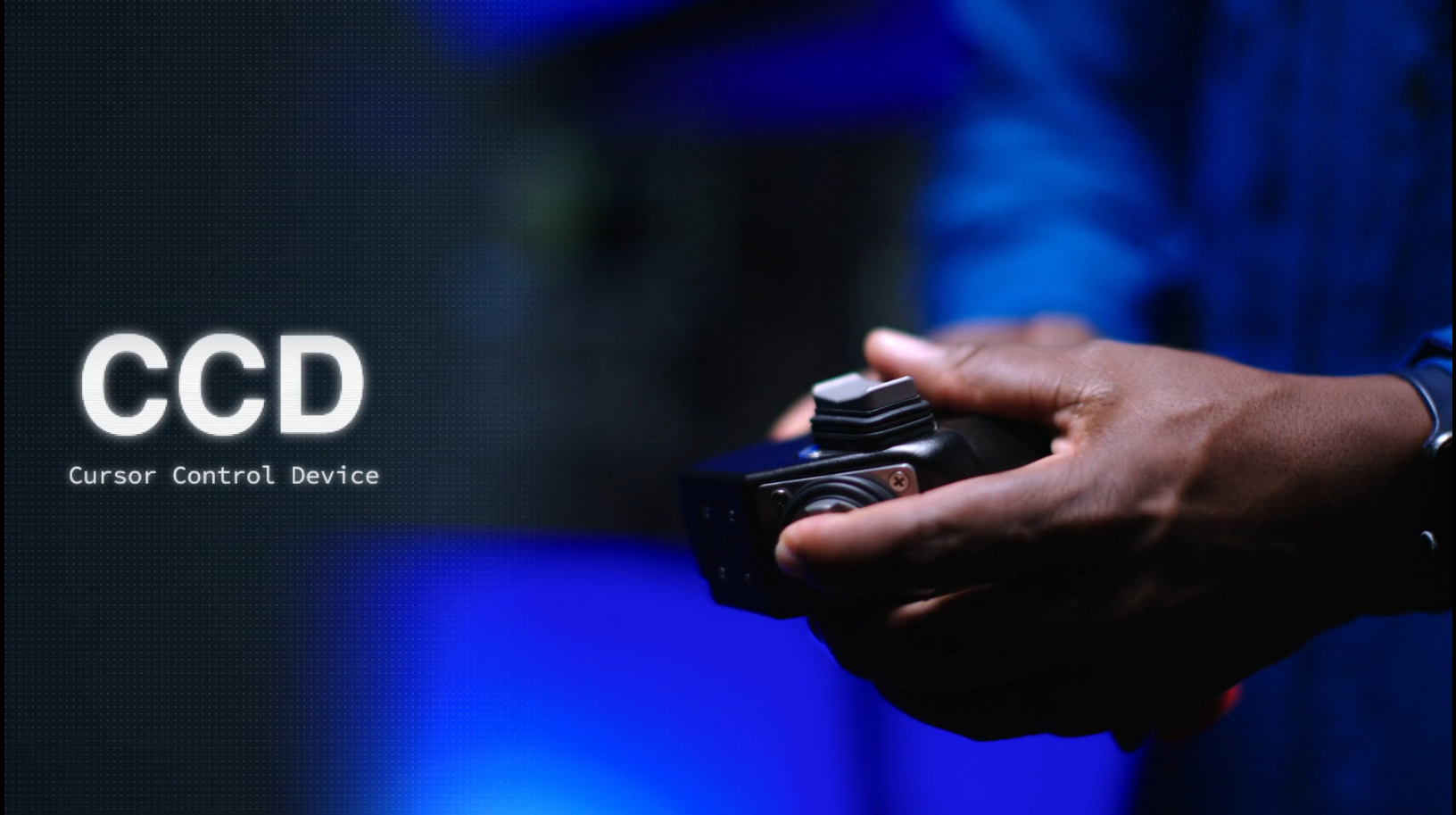
The display units are the main point of interface between the crew and the spacecraft. Through this system, the crew can receive vehicle status updates, command new operations or edit information, and interact with the spacecraft systems making the display units one of the most crucial systems onboard Orion.
Next to Orion’s displays, the spacecraft also has a series of switches, toggles, and dials on the switch interface panel. Along with switches the crew will use during normal mission operations, there is also a backup set of switches they can use to fly Orion if a display or hand controller fails.
Hand Controllers
Crew members will use two different controllers, called rotational and translational hand controllers, to steer the spacecraft.
The rotational hand controller (RHC) allows the pilot and commander to rotate the spacecraft, using their right hand to control. The RHC controls Orion’s attitude, allowing the crew to direct the orientation of Orion’s nose, to pitch up or down or roll right or left.
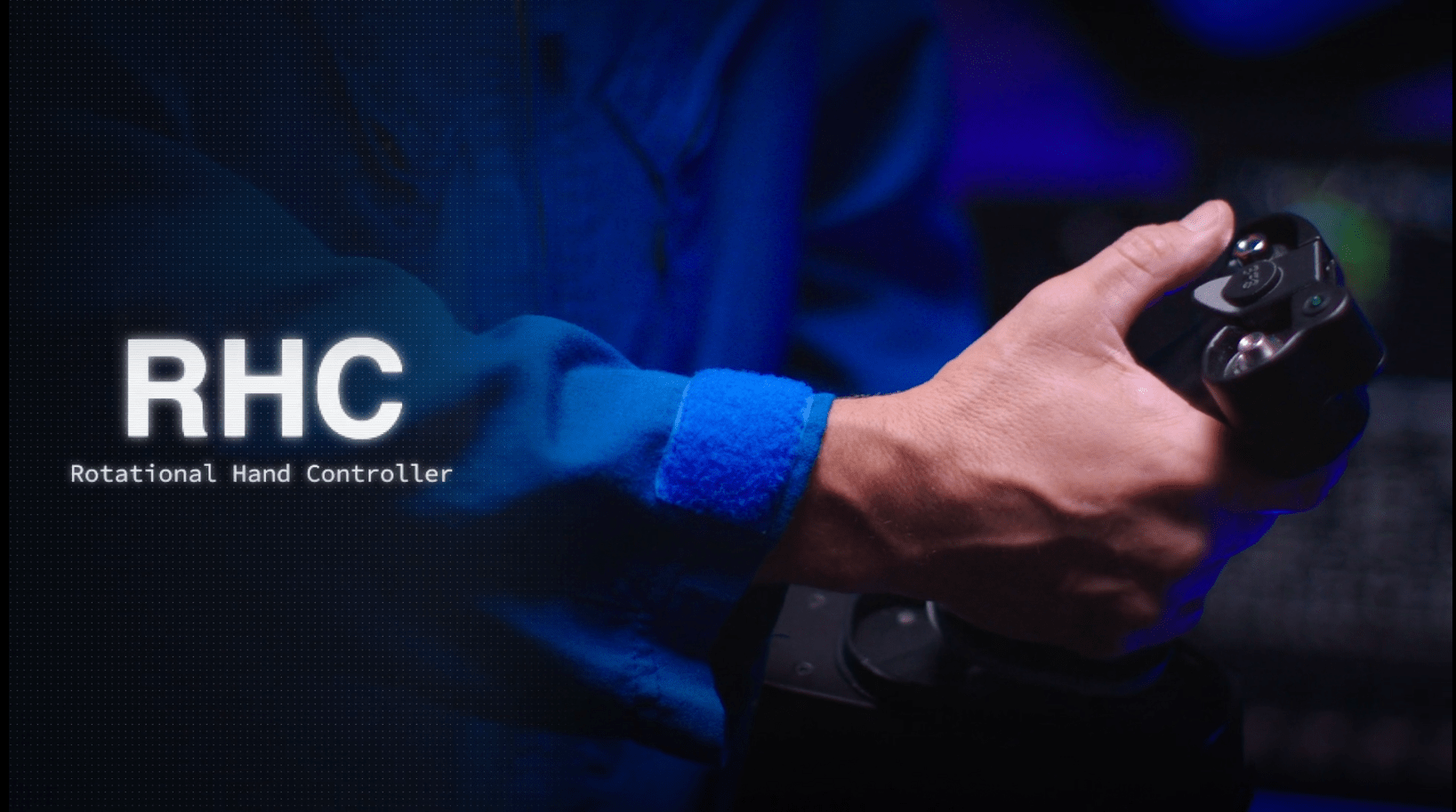
The translational hand controller (THC) will allow the spacecraft to move from one point to another, located on the right or left side of the display screens. The THC allows the crew to move the spacecraft forward and backward, pushing the THC inwards and outwards, similarly the controller can also be pushed up or down and left or right to move in the directed orientation.

Orion Crew Survival System Suits
At several points during Artemis missions, astronauts will wear a bright orange spacesuit called the Orion Crew Survival System (OCSS) suit, which is designed to protect them on their journey.
Improvements have been made from head to toe to the suit worn on the space shuttle for Orion. Elements have been reengineered to improve safety and range of motion for astronauts, and instead of the small, medium, and large sizes from the shuttle era, they will be custom fit for each crew member.
The suits can keep astronauts alive for up to six days if Orion were to lose cabin pressure during its journey, with interfaces that supply air and remove carbon-dioxide. They are also equipped with a suite of survival gear in the event astronauts must exit Orion after splashdown in the ocean before recovery personnel arrive, and the color is easily recognizable in the ocean.
The outer layer is fire resistant and a stronger zipper allows astronauts to quickly put the suit on. Improved thermal management will help keep them cool and dry. A lighter, stronger helmet improves comfort and communication, and the gloves are more durable and touch-screen compatible. Better-fitting boots will also provide protection in the case of fire and help an astronaut move more swiftly.
Astronauts will wear the suit on launch day, in emergency situations, high-risk parts of missions near the Moon, and during the high-speed return to Earth. Its design and engineering enhancements provide an additional layer of protection for astronauts and ensure they return home safely from deep space missions.
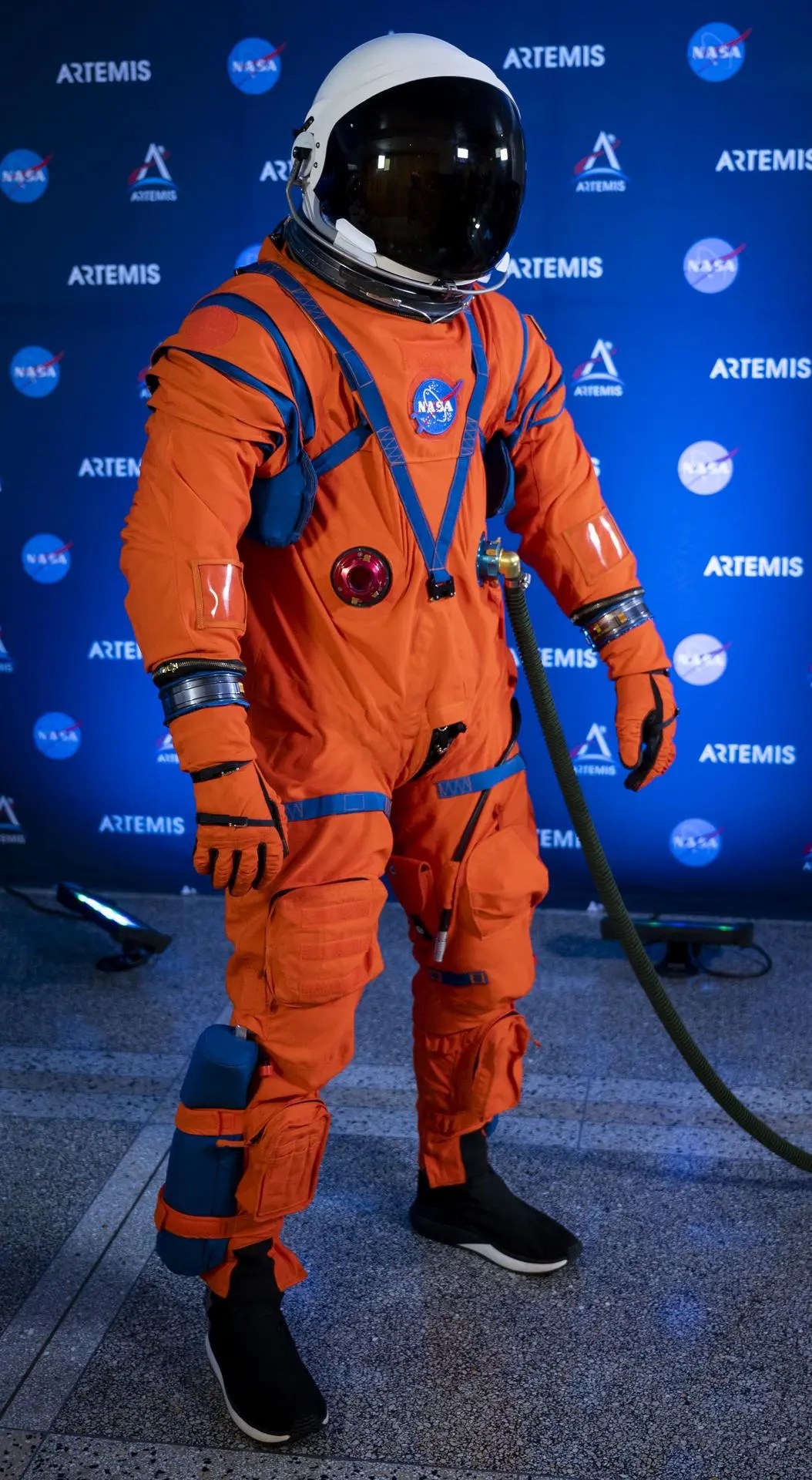
Environmental Control and Life Support Systems
Orion has been specially designed and tested to make sure astronauts can live and work safely in the capsule during multi-week Artemis missions. Countless details inside and outside the spacecraft are meticulously thought through to ensure that astronauts are protected during anything they may encounter. From life support to spacesuits to crew accommodations, engineers have worked hard to evaluate and improve Orion’s features so that astronauts can complete missions in deep space comfortably, efficiently, and safely.
On Orion, environmental control and life support systems (ECLSS) will make the crew module a habitable, safe place for astronauts and is key to survival as they travel on deep space missions.
On the International Space Station, a safe return to Earth is only hours away, but that is not the case for deep space missions. Orion provides an ECLSS that is fault tolerant and less complex than previous NASA human spacecraft. The key components of the ECLSS include atmosphere revitalization, pressure control, crew water supply, and crew waste management. For Orion, these systems must be mass and volume efficient as well as dependable.
Atmosphere revitalization is the highest priority on deep space missions. Systems must not only provide oxygen and remove carbon dioxide from the atmosphere, but also prevent gases like ammonia and acetone, which humans emit in small quantities, from accumulating. They also must provide adequate ventilation for the crew and filter particles and microbes. Orion has a new carbon dioxide and humidity removal system which is regenerable, a key for saving mass and volume on deep space vehicles. The system, when exposed to the cabin air, absorbs carbon dioxide and humidity. When exposed to the vacuum of space, the carbon dioxide and humidity are vented overboard, and the system is regenerated back to a clean state to return to cleaning the cabin air. On other human spacecraft such as the space shuttle, a method using expendable chemicals was used to remove carbon dioxide. For perspective, these chemicals took up the volume of nearly 143 basketballs. Orion’s system will take up the space of only 16 basketballs and save over 100 pounds.
Orion uses high pressure oxygen and nitrogen tanks to provide the pressure control for the crew environment. Using these tanks simplifies the system to provide for greater reliability on deep space missions. The pressure control system can be manually operated by the crew if required in a severe situation.
A water supply system stores and distributes potable water to the crew for drinking, food preparation, and medical and hygiene needs. Environmental monitoring maintains the spacecraft’s temperature, humidity and pressure, and detects when the spacecraft’s enclosed environment is compromised, causing it to become unsafe. For deep space missions, Orion has an integrated crew survival capability, using pressurized suits for several days in order to return the crew home safely in the event of a total cabin environment loss due to pressure or air contamination. Not since Apollo has this capability been required.
The ECLSS on Orion balance between the ever-present constraints of launch mass, volume, system fault tolerance, and reliability of resources to sustain astronauts and keep them safe in deep space.
Flywheel Exercise Device
Exercise is an essential requirement for crewed spaceflight missions. Without consistent exercise routines, zero gravity environments can cause a noticeable reduction in muscle mass and bone density. Artemis crews will exercise inside Orion using the flywheel exercise device, a device that uses a flywheel, a series of pulleys, and a torque limiter encased in a frame the size of an extra large shoe box, functioning like a rowing machine.
The crew will use a strap placed between their feet, attached to either a bar or a harness, to interact with the device. Pulling on the strap allows the crew to perform aerobic, resistive, and rowing exercises. The crew member straps their feet against the footplate of the device, which is held at a slight angle from the front of the frame. Using the bar, the crew can perform exercises such as bicep curls, bent-over rows, and deadlifts for resistance training, as well as rowing ergometry for aerobic training. With the harness, the crew can also perform exercises such as squats and calf raises.
The footplate, bar, and harness are stowed away during launch, ascent, and return to Earth. The flywheel is located directly below the Orion’s side hatch and above the hygiene bay, and also functions as a step into and out of the vehicle.
With three main resistance level options and other adjustments, the loading or resistance of the flywheel can be tailored to the crew member’s strength and adjusted for specific exercises. The options include “low,” “medium,” and “high” gears, which are toggled using the gear selector. The exact load of each exercise is determined by the energy put into the flywheel system by the user, similar to a yo-yo. When moved, the gear selector shifts a lever arm that engages specific pulleys that either increase or decrease the amount of resistance in the traction of the device. The highest expected load of the flywheel is 400-500 pounds.
For the Artemis II mission, the crew will use the flywheel every day of the mission except launch and landing day. Each astronaut will spend approximately 30 minutes a day performing exercises, allowing an additional 15 to 30 minutes before and after each session to allow for prep time, data collection, and cool-down. Part of this process for Artemis II includes attaching accelerometers to the flywheel and its mounting point on the Orion vehicle to ascertain the interacting forces between the exercise device and the surrounding structures. This data, amongst other observations such as video of exercise sessions, will be used to further develop the flywheel in preparation for future Artemis missions.
Potable Water Dispenser
Orion’s potable water dispenser (PWD) will give the crew easy access to water inside the crew module during their missions to the Moon. The potable water dispenser will be used to rehydrate food and drink packages and can also be used for medical emergencies.
Orion’s European Service Module will carry four water tanks, each containing about 125 pounds of water. These tanks contain bellows which pressurize the water by a regulated nitrogen source. Each of the four tanks is connected to a water manifold, which has two water lines that lead to the crew module. The two lines each have a manually operated valve at the crew end, and a quick disconnect (QD). This allows the crew to turn the water on and off at any given time.
The water that dispenses from the PWD is used for rehydrating freeze-dried food or powdered drinks. The water is analyzed to be within a crew-tolerable range for medical use, but isn’t necessarily dispensed at a controlled temperature, meaning it cannot be set it to hot or cold like a home faucet would be.
When the crew is ready to dispense water, they will attach an external potable filter assembly to one of the two QDs. The assembly includes a filter to remove impurities from the water and a small needle assembly, which is used to puncture the crew’s food or drink bag packages.
Daily tables will be generated for the crew that will inform them how long they need to open the isolation valve for a specified volume of water, based on cabin pressure, temperature, and water tank pressure. Once the crew knows their desired time, they will set up a timer or watch a clock, open the manual valve, and then close the valve once the desired time has elapsed. The crew can then disconnect their food or drink package, and if they need to warm it further, the crew can insert it in the food warmer.
Food Warmer
The Artemis II crew has designated mealtimes to follow throughout the Artemis II mission. To assist the crew during mealtimes, the Orion spacecraft will be equipped with a food warmer system. Orion has a custom-made food warmer, similar to the International Space Station (ISS) suitcase-style food warmer. The food warmer will be used to heat up rehydratable and thermostabilized food/drink packages.
During the Artemis II mission, each crew member will receive three meals per day, during a shared, 60-minute mealtime. The food warmer will be used during each of these mealtimes. Prior to launch, the Orion food warmer will be stowed in the spacecraft’s stowage lockers. Once on-orbit, it will be unstowed by the crew, and stuck to the walls or acoustic blankets with Velcro.
To power the food warmer on, crew members will plug the warmer into the power utility panel with the food warmer power cable. When not in use, the food warmer will be turned off and stowed near the potable water dispenser to save space in the cabin and allow power to be conserved. The mission control team will be in constant communication with the Artemis II crew regarding power limitations for the food warmer, allowing the crew to prepare for any restrictions. The mission control team will allow the crew to identify when power is limited, off, or when the food warmer can be utilized outside of designated mealtimes.
Universal Waste Management System
Orion’s crew module has a new space toilet, called the Universal Waste Management System (UWMS), making the essential task of going to the bathroom easier for both women and men and reducing the ever-important mass and volume of the system to be launched into deep space.
Looking back, astronauts on Mercury, Gemini, and Apollo did not have toilets. They urinated into diapers and bags and brought their solid waste mixed with bactericide in bags back home. Skylab was the first American spacecraft with a toilet, followed by the space shuttle. The space shuttle toilet was a full size larger (about 12.3 cubic feet) and a massive system, using several separate motors and fans for operations.
Orion’s toilet operates in a similar way, using air flow to pull fluid and solid waste away from the body and into the proper containers, but is improved for the needed mass and volume constraints of deep space flight in Orion, and is more accommodating to female astronauts. Based on their input, the shape of the seat for solid waste and design of the funnel for urine has been changed, and they can be used simultaneously.
It’s also self-contained and compact at about 5 cubic feet in volume, thus approximately 60 percent smaller and lighter than the space shuttle toilet, easier to use, and increases crew comfort. A new automatic air flow feature helps with odor control, fewer control interfaces simplifies crew operations, and a more ergonomic design requires less clean-up and maintenance time, as do corrosion-resistant, durable parts.
Pre-treated urine, which prevents the generation of ammonia from the breakdown of the urine, is stored in a urine tank and then vented overboard each day by the crew much like the space shuttle. Solid waste is collected in fecal canisters, which the crew replace every few days, and stored in Orion for the 21-day mission. The canisters have filtered caps to control odor and gas build up generated within the cans.
What makes the UWMS universal is that it can easily integrate into different spacecraft and systems, keeping our astronauts healthy and safe as they live, work, and learn on Orion farther from Earth than ever before.
Medical Kit
The Orion Medical Kit onboard the Orion crew module is a unique collection of hardware and items designed to provide comprehensive medical care to astronauts during their mission. The Orion Medical Kit System has four main components: the Orion Prime Medical Kit (OPMK), the Orion Secondary Medical Kit (OSMK), the Orion Medical Accessory Kits (OMAK), and the Seat Accessible Medical Items (SAMI).
The overall design of the system is adaptable and caters to the specific health needs of the crew. It supports a variety of requirements for the agency, specifically capabilities beyond low-Earth orbit and less than 30 days. Varying from routine care to emergent care, the system can address 128 identified medical conditions and has 139 medical resources at the crew’s disposal. It is influenced by the medical kits provided by the Apollo, Space Shuttle, ISS and programs.
The majority of the hardware will be placed in storage lockers within Orion, with a subset being accessible to crew in their seats while suited for easier access. The system is equipped with a wide range of medical resources, including medications (e.g. anti-inflammatory, antibiotics, space motion sickness, sleep and allergic reaction medications), therapeutics (e.g. wound, urinary, and dental care), diagnostics (e.g. vital sign, ECG and oximetry devices), and even basic life support and limited trauma care.
- The Orion Prime Medical Kit (OPMK) contains most of the medications flown for communal use, and has items bundled inside for emergent access. One of these items is the in-suit pill delivery tool for administering medication to a pressurized, suited crew member through the helmet’s drink port.
- The Orion Secondary Medical Kit (OSMK) adds to those capabilities found in the OPMK, treating clinical cases such as urinary retention, wounds, and physical injuries, limited dental care, medical device diagnostics, and medical oxygen delivery hardware. For example, the oxygen hardware contains a regulator that is connected to the Orion’s manual O2 valve, and with a mask can be used to treat smoke inhalation in the event of a fire, or decompression sickness in the event of a rapid cabin pressure change.
- Similar to the ISS Medical Accessory Kit, the Orion Medical Accessory Kit (OMAK) contains a crewmember’s personal medications and other personal items, such as prescription eyewear or custom earplugs. One of these kits is flown per each crewmember in selection with their flight surgeon’s recommendations. These are also stowed in lockers during launch and landing.
- The Seat Accessible Medical Items (SAMI) is a small container of mostly medications required to be in-reach of a restrained crewmember pre-launch, post-ascent, and post-landing. These are stored in an astronaut’s suit leg pocket.
For the Apollo missions, the contents of the medical kits were chosen based on the probability of certain conditions arising, and the Apollo crews were (for the first time) video-monitored from the ground and had biosensors to monitor their condition. For Orion, a space-to-ground support plan is detailed with audio/video connection capabilities for videoconferencing with a flight surgeon for medical discussions or guidance — like “tele-visits” with your doctor.
The Orion Medical Kit System is essential for monitoring crew health in the deep space environment and for treating different circumstances that may arise on their mission. The crew is trained on operating the available equipment, built by subject matter experts to prioritize safety on missions to the Moon.
Cabin Noise Reduction
A quiet and habitable environment is crucial for crew health and performance. The interior of the Orion capsule includes numerous noise-producing systems and components that operate continuously, intermittently, or impulsively during Artemis missions, and needs adequate noise suppression. to remain habitable for the crew. To protect for crew health and performance, NASA defines acoustic requirements applicable to each phase of the mission for the different types of noise producers.
The confined volume of the Orion cabin and close proximity of the flight crew to significant noise-producing equipment result in a very challenging acoustic environment; however, the cabin includes several noise control treatments to help mitigate the acoustic environment within acceptable limits. Absorptive acoustic blankets cover many surfaces in the cabin to reduce reverberation. The hygiene bay also has noise dampening foam inside to suppress reverberation during Universal Waste Management System use.
Additionally, since the cabin fan operates continuously and significantly contributes to the background noise environment, two mufflers located in the ducting upstream and downstream of the cabin fan were designed to yield significant duct-borne noise reduction. These mufflers are implemented on the Artemis II spacecraft.
In addition to noise control treatments, the crew will have access to many types of hearing protection, including over-the-ear headsets and noise-cancelling earbuds. NASA predicts the 24-hour noise exposure of the crew based on test data to determine if certain tasks or mission phases require hearing protection for the protection of their health. The crew may also use hearing protection based on their personal preference. All of these measures combine to ensure safe noise exposure levels for the crew during the Artemis II mission.
Radiation Shelter
One of the many challenges astronauts face during journeys to deep space is radiation. Earth’s magnetosphere partially shields the ISS astronauts from radiation from the Sun (e.g., solar particle radiation and galactic cosmic rays), however, when astronauts travel into deep space, they will no longer have that protection.
In the case of a radiation contingency such as a solar particle event, NASA developed a system to repurpose resources onboard Orion to put enough low mass materials, such as stowage bags, between the astronauts and radiation source, to protect the crew without increasing total mass of the spacecraft during their missions to the Moon.
Orion will be equipped with a radiation-sensing instrument integrated into the vehicle called the Hybrid Electronic Radiation Assessor, or HERA, to provide a warning if crew members need to take shelter in the case of a radiation event. They will have up to one hour to prepare the shelter.
The crew will open two large storage bays located beneath their seats in the central part of the crew module and remove all the stowage bags in the bays. They will then strategically position the stowage bags so that the mass of the bags creates a barrier between the bays and the less shielded parts of the crew module. For example, the bottom of Orion where the heat shield and service module are attached will provide more shielding than other areas, and stowage bags can be used for parts of the spacecraft’s interior with less shielding. The method protects the crew by shielding localized radiation points using existing stowage, while not adding mass to the crew module itself.
Two astronauts will get into each storage bay. The crew will bring necessary food, water, medical supplies, air lines, and computers inside with them since they may need to stay inside the storage bays for up to 24 hours. Once the danger has passed, they can leave the shelter, restow their gear, and continue their mission.
The Orion crew module will be equipped with other systems on board to help the crew monitor radiation levels. Five ESA Active Dosimeter (EAD) detectors will be mounted around Orion according to optimal location, such as least and most protected areas from radiation around Orion. The EADs will assess radiation levels in the surrounding deep space environment, collecting data that will help the crew to maintain radiation awareness.
Secondary Egress Ladder
The Orion spacecraft incorporates a secondary egress ladder, made of nylon webbing straps with metal steps, as a contingency measure for crew egress in scenarios where the side hatch that the crew would nominally exit from is obstructed or inaccessible. This feature addresses critical safety concerns, ensuring astronauts can safely exit the spacecraft if standard exit routes are compromised due to mechanical issues of the side hatch.
When Orion splashes down in the Pacific Ocean at the end of the mission, it is expected the crew module uprighting system (CMUS) will deploy and reorient the capsule right side up, allowing for the crew to exit normally through the side hatch. In the case that the capsule is in its upright position but there is a side hatch malfunction, the secondary egress ladder will provide a reliable way for the crew to climb up and out of the docking hatch.
A winch would be used to open the docking hatch in this scenario. Both the winch and secondary egress ladder are required to allow the crew to exit from the docking hatch. The winch is mounted on the “ceiling” next to the docking hatch and has webbing straps like the ladder that are routed through the handles of the docking hatch to cradle it and allow for a controlled “drop” of the hatch. The hatch is hinged to the vehicle, but without the webbing, it would fall against the side of the tunnel. This webbing and winch also allow the crew to pull the hatch up for a docking hatch egress in the event the capsule is in the upside-down position.
The secondary egress ladder is stowed within the interior of the crew module, behind a soft goods cover on the wall of the docking hatch tunnel. The egress ladder is stowed in a stacked configuration, with the metal steps one on top of the next. When deployed, the webbing straps of the ladder attach to the floor (or backbone structure) with carabiners at two locations to prevent movement.
